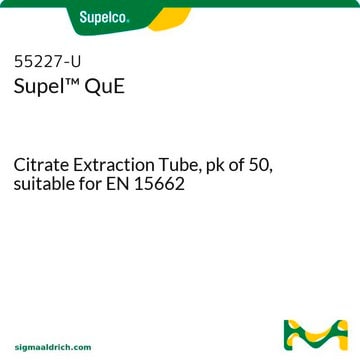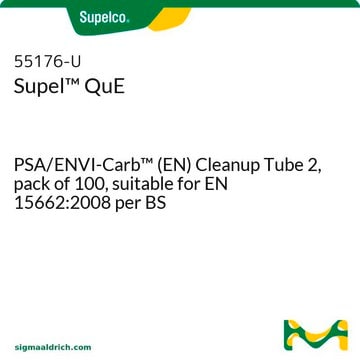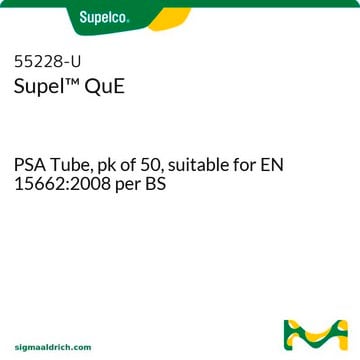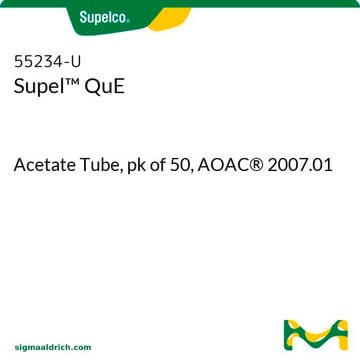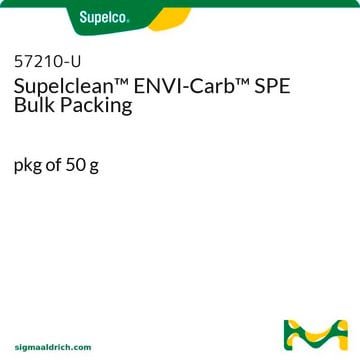Kluczowe dokumenty
55446-U
Supel™ QuE QuEChERS tube
PSA/ENVI-Carb Tube 1, pk of 50, suitable for EN 15662:2008 per BS, centrifuge tube volume 15 mL , Shaker Compatible
Synonim(y):
QuEChERS
Wybierz wielkość
702,00 zł
Wybierz wielkość
About This Item
702,00 zł
Polecane produkty
Nazwa produktu
Supel™ QuE, PSA/ENVI-Carb Tube 1, pk of 50, suitable for EN 15662:2008 per BS, centrifuge tube volume 15 mL , Shaker Compatible
Materiały
polypropylene tube
Poziom jakości
agency
suitable for BS EN 15662:2008
linia produktu
Supel™
skład
Magnesium Sulfate, 900 mg
Supelclean™ ENVI-Carb, 15 mg (Cat. No. 57210-U)
Supelclean™ PSA, 150 mg (Cat. No. 52738-U)
opakowanie
pk of 50
metody
QuEChERS: suitable
pojemność probówki reakcyjnej (do wirowania)
15 mL , Shaker Compatible
grupa aktywna macierzy
PSA phase
carbon phase
Zastosowanie
food and beverages
Szukasz podobnych produktów? Odwiedź Przewodnik dotyczący porównywania produktów
Opis ogólny
Using the QuEChERS method, food/agricultural samples are first extracted with an aqueous miscible solvent (e.g., acetonitrile) in the presence of high amounts of salts (e.g., sodium chloride and magnesium sulfate) and/or buffering agents (e.g. citrate) to induce liquid phase separation and stabilize acid and base labile pesticides, respectively. Upon shaking and centrifugation, an aliquot of the organic phase is subjected to further cleanup using SPE. Unlike traditional methods using SPE tubes, in dispersive SPE, cleanup is facilitated by mixing bulk amounts of SPE (e.g., Supelclean PSA, ENVI-Carb, and/or Discovery DSC-18) with the extract. After sample cleanup, the mixture is centrifuged and the resulting supernatant can either be analyzed directly or can be subjected to minor further treatment before analysis.
Supelco carries a line of vials and centrifuge tubes containing pre-determined amounts of salts and SPE sorbents to support the most common method configurations used today.
Kompatybilność
Przydatność
Informacje prawne
Nie możesz znaleźć właściwego produktu?
Wypróbuj nasz Narzędzie selektora produktów.
Kod klasy składowania
13 - Non Combustible Solids
Klasa zagrożenia wodnego (WGK)
WGK 1
Temperatura zapłonu (°F)
Not applicable
Temperatura zapłonu (°C)
Not applicable
Wybierz jedną z najnowszych wersji:
Masz już ten produkt?
Dokumenty związane z niedawno zakupionymi produktami zostały zamieszczone w Bibliotece dokumentów.
Klienci oglądali również te produkty
Produkty
Rapid & accurate analysis of 208 pesticides and their metabolites in a fruit sample using Supel™ QuE QuEChERS mixes for sample preparation and GC-MS/MS.
Pesticide residue analysis of 331 pesticides and 44 metabolites in cabbage samples using Supel™ QuE QuEChERS mixes and Purospher® STAR RP-18e column.
Active Filters
Nasz zespół naukowców ma doświadczenie we wszystkich obszarach badań, w tym w naukach przyrodniczych, materiałoznawstwie, syntezie chemicznej, chromatografii, analityce i wielu innych dziedzinach.
Skontaktuj się z zespołem ds. pomocy technicznej